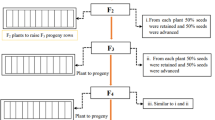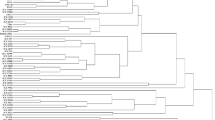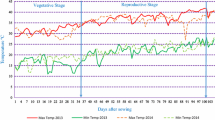Abstract
Genetic analysis of ten quantitative traits related to crop duration in chickpea was carried out using three F 2 sib-populations; 272-2 × CDC Anna, 298T-9 × CDC Anna and 298T-9 × CDC Frontier. F 3 and F 4 families from these populations were further evaluated for traits found important in the initial study. Also, 112 recombinant inbred lines (RILs) of chickpea cross ICCV 2 × JG 62 were evaluated for days to flowering, days to maturity and reproductive period. An analysis of the F 2 population data using the mixed model approach revealed that the additive component of variance was significant for days to flowering, days to first podding and days to first pod maturity, while dominance genetic variance was significant for morphological components of crop duration such as height to first pod and height at flowering. Comparatively high heritability estimates (39–48%) were obtained for days to flowering, days to first pod maturity, percent pod maturity at four months after planting and days to maturity based on offspring-parent (F 4 and F 3 generations) regression and/or analysis of variance for the RIL population. The predicted gain from selection as a percentage of the population mean was low (5% or less) for these key components of crop duration owing to the low variability detected within the populations, the exception being percent pod maturity. To maximize gain from selection in these traits, it is therefore, essential to increase genetic variability among the progenies, potentially through multi-parent crosses that may involve gene introgression from across desi and kabuli types of chickpea and from wild progenitors.
Similar content being viewed by others
Abbreviations
- DF:
-
days to flowering
- DFP:
-
days to first podding
- PEP:
-
pod establishment period
- DFPM:
-
days to first pod maturity
- PFP:
-
pod filling period
- PPM:
-
percent pod maturity
- DM:
-
days to maturity
- RP:
-
reproductive period
- NNFP:
-
number of nodes to first pod
- HFP:
-
height to the first pod
- HF:
-
height at flowering
- IH:
-
increase in height after flowering
References
Ahmad F, Slinkard AE (1992) Genetic relationships in the genus Cicer L. as revealed by polyacyrlamide gel electrophoresis and seed storage proteins. Theor Appl Genet 86:688–692
Arunachalam V, Bandyopadhyay A, Nigam SN, Gibbons RW (1984) Heterosis in relation to genetic divergence and specific combining ability in groundnut (Arachis hypogaea L.). Euphytica 3:33–39
Bhat DD, Singh DP (1980) Combining ability in chickpea. Indian J Gent Plant Breed 40:456–460
Busch RH, Janke JC, Frohberg RC (1974) Evaluation of crosses among high and low yielding parents of spring wheat (Triticum aestivum L.) and bulk prediction of line performance. Crop Sci 14:47–50
Collaku A, Harrison SA (2005) Heritability of waterlogging tolerance in wheat. Crop Sci 45:722–727
Dhaliwal HS, Gill AS (1973) Studies of heterosis, combining ability and inheritance of yield and yield components in a diallel cross of Bengal gram (Cicer arietinum L.). Theo App Genet 43:381–386
Dudley JW, Moll RH (1969) Interpretation and use of estimates of heritability and genetic variance in plant breeding. Crop Sci 9:258–262
Falconer DS (1989) Introduction to Quantitative Genetics, 3rd edn. Longman Scientific & Technical, UK
Federer WT (1956) Augmented (or hoonuiku) designs. Hawaii Planters Records 55:191–208
Ghaderi A, Adams MW, Nassib AM (1984) Relationship between genetic distance and heterosis for yield and morphological traits in dry edible bean and faba bean. Crop Sci 24:37–42
Gowda CLL, Bahl PN (1978) Combining ability in chickpea. Indian J Gent Plant Breed 38:245–251
Kidambi SP, Sandhu TS, Bhullar BS (1988) Genetic analysis of developmental traits in chickpea. Plant breed 101:225–235
Kumar J, Abbo S (2001) Genetics of flowering time in chickpea and its bearing on productivity in semiarid environments. Adv in Agron 72:107–138
Kumar J, van Rheenen HA (2000) A major gene for time of flowering in chickpea. J Hered 91:67–68
Kumar S, van Rheenen HA, Singh O (1999) Genetic analysis of different components of crop duration in chickpea. J Genet Breed 53: 189–200.
Lynch M, Walsh B (1998) Genetics and analysis of quantitative traits. Sinauer Associated, Inc., Sunderland, MA, USA
Malhotra RS, Singh KB (1989) Detection of epistasis in chickpea. Euphytica 40:169–172
Maynez M, Moreno MT, Gil J (1993) Desi/kabuli introgression for yield improvement in chickpea (Cicer arietinum L.). J Genet Breed 47:61–64
Miller RG (1974) The jackknife – a review. Biometrika 61:1–15
Muehlbauer FJ, Singh KB (1987) Genetics of chickpea. In:Saxena MC, Singh KB (eds) The Chickpea C.A.B International, London, UK, pp 99–125
Nyquist WE (1991) Estimation of heritability and prediction of selection response in plant populations. Critical Rev in Plant Sci 10:235–322
Roff DA (1997) Evolutionary Quantitative Genetics. Chapman & Hall, New York, USA
SAS Institute Inc (1999) SAS language and procedure: Usage version 8-2, Cary, NC, USA
Scott RA, Milliken GA (1993) A SAS program for analyzing augmented randomized complete-block design. Crop Sci 33:865–867
Singh SP (2001) Broadening the genetic base of common bean cultivars: A review. Crop Sci 41:1659–1675
Singh O, Gowda CLL, Sethi SC, Dasgupta T, Kumar J, Smithson JB (1993) Genetic analysis of agronomic characters in chickpea III. Estimates of genetic variances from line × tester mating designs. Theor Appl Genet 85:1010–1016
Singh O, Gowda CLL, Sethi SC, Sasgupta T, Smithson JB (1992) Genetic analysis of agronomic characters in chickpea. I. Estimates of genetic variances from diallel mating designs. Theor Appl Genet 83:956–962
Smith JD, Kinman ML (1965) The use of parent-offspring regression as an estimator of heritability. Crop Sci 5:595–596
Summerfield RJ, Roberts EH (1988) Photothermal regulation of flowering in pea, lentil, faba bean and chickpea. In: Summerfield RJ (ed) World Crops: Cool Season Food Legumes. Kluwer Academic Publishers, Dordecht, The Netherlands, pp 911–922
Tefera H, Assefa K, Hundera F, Kefyalew T, Tefera T (2003) Heritability and genetic advance in recombinant inbred lines of tef (Eragrostis tef). Euphytica 131:91–96
Vandenberg A, Warkentin T, Slinkard A (2003) CDC Anna desi chickpea. Can J Plant Sci 83:797–798
Warkentin T, Banniza S, Vandenberg A (2005) CDC Frontier kabuli chickpea. Can J Plant Sci (in press)
Wu J, Zhu J, Jenkins JN (2003) Mixed linear model approaches for quantitative genetic models. In: Kang MS (ed) Handbook of Formulas and Software for Plant Geneticists and Breeders. The Haworth Press Inc. Press, Binghamton, New York, USA, pp 171–180
Author information
Authors and Affiliations
Corresponding author
Rights and permissions
About this article
Cite this article
Anbessa, Y., Warkentin, T., Vandenberg, A. et al. Heritability and predicted gain from selection in components of crop duration in divergent chickpea cross populations. Euphytica 152, 1–8 (2006). https://doi.org/10.1007/s10681-006-9163-y
Received:
Accepted:
Published:
Issue Date:
DOI: https://doi.org/10.1007/s10681-006-9163-y




